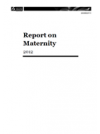The Report on Maternity series provides annual health statistics about women giving birth, their pregnancy and childbirth experience, and the characteristics of live-born babies in New Zealand. This publication is focused on women who gave birth, and the babies who were born, in 2012. A summary of the key findings is provided below.
Key Results
Birth rates remained stable
In 2012, 62,321 women were recorded as giving birth. This equates to a birth rate (the proportion of females aged 15–44 years in the population) of 68.9 per 1000 females of reproductive age, similar to the 2011 rate of 68.6 per 1000 females of reproductive age. Overall, birth rates remained stable from 2008 to 2012, ranging from 68.6 to 71.1 births per 1000 females of reproductive age.
The distribution of birth rates by age group, ethnic group and deprivation quintile of residence also remained fairly consistent over this time.
Women giving birth were predominantly European, aged 25–34 years, residing in more deprived areas, and had had at least one previous birth
Of the women giving birth in 2012:
- more than half were between the ages of 25 and 34 years
- almost half were European and about a quarter were Māori
- the median age for Māori and Pacific women giving birth was five years younger than for Asian and European women
- over a quarter resided in the most deprived areas
- almost 60% had previously given birth.
Most women received care from a midwife Lead Maternity Carer
The vast majority of women were registered with and received care from a Lead Maternity Carer (LMC) during their pregnancy and postnatal period. A midwife LMC was the most common practitioner type.
More than half were registered to receive care within the first trimester of pregnancy in 2012. All district health board regions had more women registered with an LMC within the first trimester in 2012 than in 2008.
Most women gave birth at a secondary or tertiary maternity facility
The vast majority of women gave birth at a maternity facility, with approximately 87% giving birth at a secondary or tertiary facility.
Home births were more common among Māori or European women, in their 30s
Approximately 3% of women giving birth had a home birth in 2012. The proportion of home births has remained stable over the last decade. Home births were more common among:
- women in the 30–39 years age group
- Māori and European women
- women residing in the West Coast DHB region.
Elective caesarean sections have increased
Two-thirds of women had a spontaneous vaginal birth, a quarter had a caesarean section and the remaining women had an assisted birth.
Between 2003 and 2012 there was an increase in the proportion of elective caesarean sections and a slight decrease in spontaneous vaginal births. The proportion of women having an emergency caesarean section or assisted birth showed little variation over the same time period.
Women who had a higher proportion of caesarean sections were:
- aged 35 years or more
- in the Asian or in the European or Other ethnic groups
- residing in the least deprived areas.
One in four women had some form of intervention
In 2012 one in four women giving birth had at least one form of intervention: 23% had an induction, 28% had their labour augmented and 26% had an epidural. Approximately 12% of women had an episiotomy.
More babies were male than female
There were 62,739 live-born babies in 2012, 51.1% of whom were male.
No change in average birthweight
Babies born in 2012 had the same average birthweight as babies born between 2009 and 2011 at 3.42 kg, with male babies on average heavier than female babies.
Approximately 6% of babies were born with a low birthweight. Female babies were more likely to have a low birthweight than male babies.
Median gestation was 39 weeks
The vast majority of babies were born at term in 2012, while 8% were born preterm.
The median gestation each year between 2008 and 2012 was 39 weeks, a decrease from the median gestation of 40 weeks between 2003 and 2007.
Of the babies born at term, 1.9% had a low birthweight. The highest percentage was among Asian babies and those born to older women.
Most babies were exclusively or fully breastfed
Almost 80% of babies were exclusively or fully breastfed at two weeks after birth. The highest proportion of exclusively or fully breastfed babies were among babies:
- born to women aged 30–39 years
- in the European or Other ethnic group
- residing in the least deprived areas
- residing in the West Coast DHB region.

